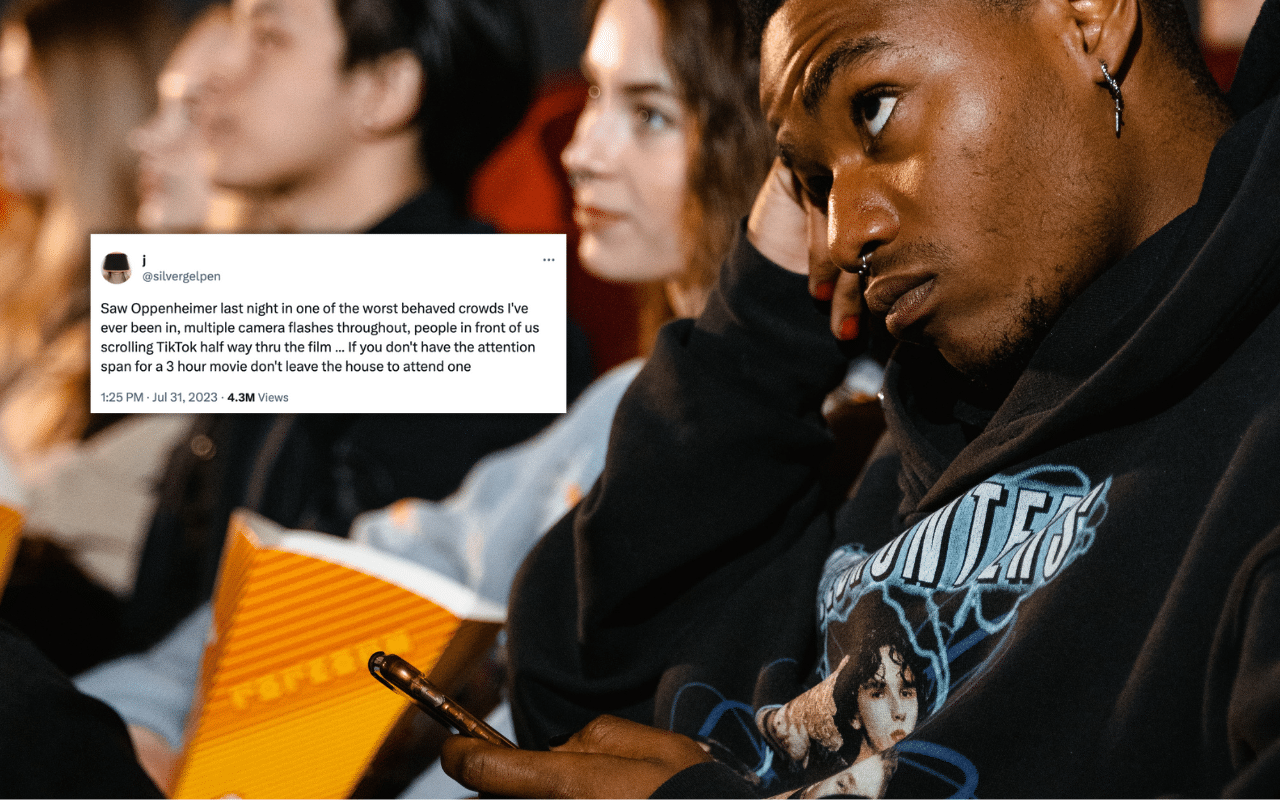
The internet is in debate over why we struggle to consume content without scrolling at the same time.
The conversation started on July 31st when Twitter user @silvergelpen posted about their experience seeing Oppenheimer in cinemas, saying the theatre audience was “one of the worst crowds I’ve ever been in” because people were taking photos and scrolling TikTok throughout the film.
The tweet went viral, reaching over 4.3 million views in three days.
Amid the troll responses and people saying they should have resorted to violence against the TikTok scroller, hundreds of users related to @silvergelpen’s experience, noting that theatre etiquette has drastically shifted since the pandemic.
Saw Oppenheimer last night in one of the worst behaved crowds I've ever been in, multiple camera flashes throughout, people in front of us scrolling TikTok half way thru the film … If you don't have the attention span for a 3 hour movie don't leave the house to attend one
— j (@silvergelpen) July 31, 2023
Several internet culture experts have shared their theories about this new phenomenon like journalist Kat Tenbarge, who suggested that we’ve reached the point of a “serious internet addiction problem” that society has yet to address.
Internet addiction is a controversial concept. The medical community is divided on whether it’s a mental health disorder in its own right or a manifestation of other compulsive disorders.
Regardless, research shows that people, particularly teens, became increasingly attached to their phones during the pandemic. A 2021 study found that non-academic screen time increased for US pre-teens and teenagers from 3.8 hours per day pre-pandemic to 7.7 hours per day during the pandemic.
The research also found that poorer mental health and greater perceived stress were associated with higher screen time, while greater social support and coping behaviours were associated with lower screen time.
Internet addiction is not yet formally recognised by the American Psychiatric Association’s Diagnostic and Statistical Manual of Mental Disorders (DSM-5-TR), though an addiction to online gaming, called internet gaming disorder, was included in 2022.
People getting on their phones during long movies IN THE MOVIE THEATER seems to be happening much more frequently and I personally think there’s a serious internet addiction problem that we as a culture have yet to articulate let alone address
— Kat Tenbarge (@kattenbarge) August 1, 2023
Ryan Broderick, the writer of the Garbage Day substack, questioned if this behaviour indicates that online entertainment has surpassed more traditional forms of entertainment, like TV and film, to become our “default”.
A 2022 report by NewZoo supports Broderick’s theory, finding that US Gen Z respondents spend an average of 13.92 hours engaging on social media and just 11.85 hours watching TV.
Similarly, 2023 research by Deloitte finds that “social media is looking more like 21st century TV” as platforms prioritise interests over connection.
“Instead of organizing content around whom we follow, feeds are becoming more algorithmic, using our interactions and interests to deliver more ‘suggested’ content, ads, and recommendations, personalized to each user. Social media is still interactive, and the content is influenced by the crowd, but it’s becoming a more lean-back-and watch experience,” the report reads.
With approximately 60% of media engagement occurring on mobile devices now, it’s not far-fetched to consider that our “default” entertainment has shifted to platforms like TikTok, Reels, and YouTube.
This is definitely possible, but it’s also worth considering that we are starting to enter a world where sitting down to watch a TV show or a movie without using your phone feels as weird as old photos of people sitting down to listen to the radio 🤔 https://t.co/enY5jlKM9P
— Ryan Broderick (@broderick) August 1, 2023
To be clear, I think both can be true, I just think we’re still phrasing movies and TV as the default when maybe it has finally tilted to the other side
— Ryan Broderick (@broderick) August 1, 2023
Finally, a theory by podcast host and author Linda Holmes noted the similarities between people using their phones at the cinema and the new trend of fans throwing objects at artists on stage.
Holmes suggested that people have a (somewhat recent) inability to consume art without centering themselves because “in order for an experience to be validated, it has to be shareable, and to be shareable, you have to be a character.”
While this “pics or it didn’t happen” ethos has been around since the early days of Instagram, it’s becoming more prevalent as the percentage of the population that grew up online increases over time.
“What matters is not so much the content of your updates but their existing at all,” wrote Jacob Silverman for The Guardian in 2015. “Social broadcasts are not communications; they are records of existence and accumulating metadata.” Even back then, Silverman observed that the digital landscape, built on attention and visibility, was impacting how society interacted with experiences in real life.
Holmes takes Silverman’s observation a step further, claiming that in 2023, the point of an experience is not the experience itself nor the social media content, but rather, the opportunity to create a sharable story in which you are a character.
“But this entire idea of forcing the art to interact with you individually — getting an artist to react to something you did, making content *while watching* — it all feels like part of the same thing, with is a lack of experience with things you just take in,” she tweeted.
You have to be *part* of the story. You have to be doing something. In order for an experience to be validated, it has to be shareable, and to be shareable, you have to be a character. You can't be an observer. Sitting quietly and watching a movie and then leaving won't work.
— Linda Holmes thisislindaholmes.com (@lindaholmes) August 2, 2023
I'm not sure it's not related to the expectation that the very first ask for so many people who meet a stranger they admire is a selfie. The meeting with the person isn't really the point. The creation of something shareable, a story in which you're a character, is the point.
— Linda Holmes thisislindaholmes.com (@lindaholmes) August 2, 2023
Though these theories are far from comprehensive, the discussion about our inability to stop scrolling, even in a movie cinema filled with people, indicates that it has never been harder to get off and stay off the internet.
And at a time when creating a story for social media feels more important than living out the story authentically, it’s clear that the line between what is real and what is made out to be real is becoming increasingly blurry.


